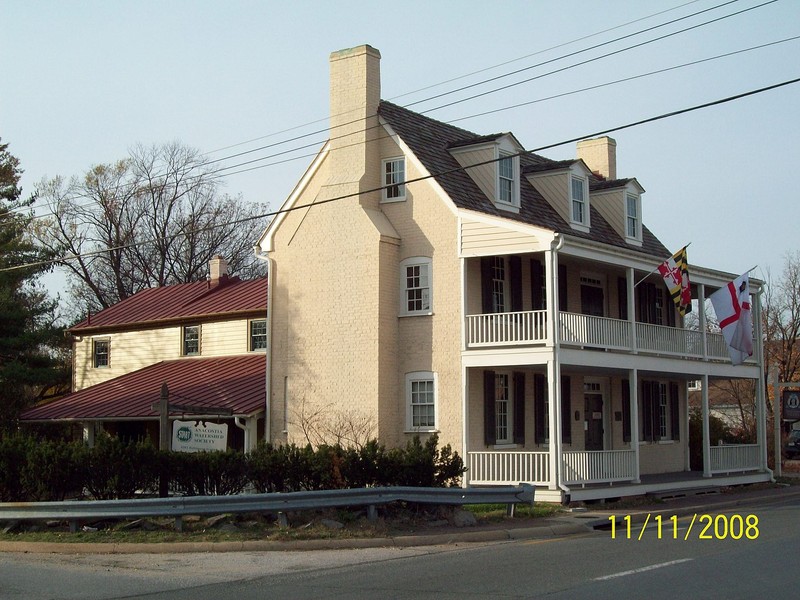George Washington House (The Indian Queen Tavern)
Introduction
Text-to-speech Audio
Images
George Washington House (The Indian Queen Tavern)

Backstory and Context
Text-to-speech Audio
The George Washington House gained its reputation through an assumption that George Washington once spent the night there. While that may not be true, he likely visited the tavern. Moreover, the structure stands as a reminder of the significance of taverns, ordinaries, and public houses during Washington's time. Furthermore, owners and occupants of the home have included niece of the town's namesake, a British officer during the War of 1812 (he commandeered it during the war), the populist leader Jacob Coxey during his 1894 march on Washington and pioneering hot-air balloonist, Peter Carnes.
Washington often toured parts of the nation and regularly relied on the network of public houses and taverns as a source of overnight lodging, most of which left him unimpressed. Washington's displeasure came even though many towns decided to forgo placing the President in their established taverns; they instead transformed private homes into inns to better acquaint the President. Washington's experience led him to push for federal funding and planning centered on developing hotels (as we now refer to them) so that visiting dignitaries and government officials could stay comfortably (or more).
On one of his travels, he commented in his journal about the ineptitude of most of the lodging. And then he mentioned: "At Bladensburgh nine miles beyond a good house is kept by one Ross (sign of the Indian Queen)." The note exists as the only evidence that attaches Washington to the Indian Queen Tavern (then owned by Richard Ross). Of course, had the first President slept at the tavern, it would have been in the building next door as the remaining structure was not used as a tavern at the time. Still, in the 1870s, as the nation celebrated its centennial, the journal entry provided enough evidence for it to become known as the "George Washington Hotel."
Legends aside, the association with Washington's travels serves as a reminder as to the economic and societal significance of public houses and taverns in early America. Indeed, communities often felt it necessary to provide liquor licenses before developing churches, schools, or formal governments. Taverns existed as political halls (formally and informally), hotels, marketplaces, and of course, drinking and eating establishments.
But, the home also enjoys a more tangible history, as well. Between 1774 and 1783, Peter Carnes managed the George Washington House and associated complex. Carnes conducted the first authenticated balloon ascent in the United States in Baltimore on June 24, 1784. In front of a crowd, he sent his home-made balloon aloft in with a thirteen-year-old boy aboard.
The structure also stands as a monument to its creator, Jacob Wirt and his soon William. Jacob built the home and associated lots in Bladensburg during the early 1760's. After his passing, the home was sold (1792) by the Maryland Assembly with funds going to Jacob's son, William. The younger Wirt studied law and went on to become a U.S. Attorney General.
Meanwhile, In 1812, a British officer commandeered the building during the war with the U.S. And then in 1894, a different army of sorts took possession of it; "Coxey's Army" stayed on its grounds. Coxey represented a group of protesters who marched from Ohio to Washington, D.C., to implore the government to solve the nation's nearly 20% unemployment rate. All told, the home has served the town for more than two centuries. Today, it's home to the Anacostia Watershed Society.
Sources
Beckwith, Ryan Teague. "The True Story of Route 1's Washington House." The Hyattsville Wire (Hyattsville) April 23rd 2018. https://www.hyattsvillewire.com/2018/04/23/george-washington-house/
MacLaren, Andrew C., Mark E. Young, and Sean Lochrie. "Enterprise in the American West: Taverns, Inns and Settlement Development on the Frontier during the 1800s." International Journal of Contemporary Hospitality Management 25, no. 2 (2013): 264-281.
Sandoval-Strausz, A. K.. "A Public House for a New Republic: The Architecture of Accommodation and the American State, 1789-1809." Perspectives in Vernacular Architecture 9 (2003): 54-70.
Yoder, Paton. "Tavern Regulation in Virginia: Rationale and Reality," The Virginia Magazine of History and Biography 87, no. 3 (1979): 259–78.
Walton, John. "Nomination Form: George Washington's House (Indian Queen Tavern)." National Register of Historic Places. nps.gov. August 7, 1974. https://npgallery.nps.gov/GetAsset/36599810-7588-4889-b65e-d1e256c4cd3f
By Pubdog (talk) at en.wikipedia - Own work (Original text: I created this work entirely by myself.), Public Domain, https://commons.wikimedia.org/w/index.php?curid=6384087
